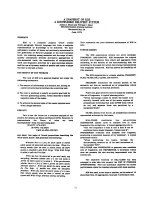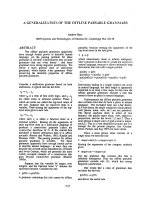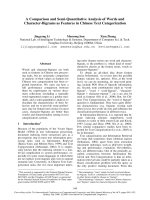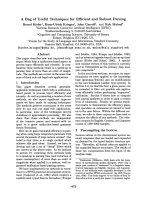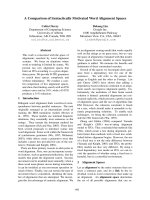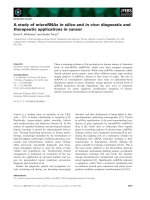Báo cáo khoa học: "A Comparison of Syntactically Motivated Word Alignment Spaces" doc
Bạn đang xem bản rút gọn của tài liệu. Xem và tải ngay bản đầy đủ của tài liệu tại đây (140.52 KB, 8 trang )
A Comparison of Syntactically Motivated Word Alignment Spaces
Colin Cherry
Department of Computing Science
University of Alberta
Edmonton, A B, Canada, T6G 2E8
Dekang Lin
Google Inc.
1600 Amphitheatre Parkway
Mountain View, CA, USA, 94043
Abstract
This work is concerned with the space of
alignments searched by word alignment
systems. We focus on situations where
word re-ordering is limited by syntax. We
present two new alignment spaces that
limit an ITG according to a given depen-
dency parse. We provide D-ITG grammars
to search these spaces completely and
without redundancy. We conduct a care-
ful comparison of five alignment spaces,
and show that limiting search w ith an ITG
reduces error rate by 10%, while a D-ITG
produces a 31% reduction.
1 Introduction
Bilingual word alignment finds word-level corre-
spondences between parallel sentences. The task
originally emerged as an intermediate result of
training the IBM translation models (Brown et
al., 1993). These models use minimal linguistic
intuitions; they essentially treat sentences as flat
strings. They remain the dominant method for
word alignment (Och and Ney, 2003). There have
been several proposals to introduce syntax into
word alignment. Some work w ithin the framework
of synchronous grammars (Wu, 1997; Melamed,
2003), while others create a generative story that
includes a parse tree provided for one of the sen-
tences (Yamada and Knight, 2001).
There are three primary reasons to add syntax to
word alignment. First, one can incorporate syntac-
tic features, such as grammar productions, into the
models that guide the alignment search. Second,
movement can be m odeled more naturally; when a
three-word noun phrase moves during translation,
it can be modeled as one movement operation in-
stead of three. Finally, one can restrict the type of
movement that is considered, shrinking the num-
ber of alignments that are attempted. We investi-
gate this last advantage of syntactic alignment. We
fix an alignment scoring model that works equally
well on flat strings as on parse trees, but we vary
the space of alignments evaluated with that model.
These spaces become smaller as more linguistic
guidance is added. We measure the benefits and
detriments of these constrained searches.
Several of the spaces we investigate draw guid-
ance from a dependency tree for one of the
sentences. We will refer to the parsed lan-
guage as English and the other as Foreign. Lin
and Cherry (2003) have shown that adding a
dependency-based cohesion constraint to an align-
ment search can improve alignment quality. Un-
fortunately, the usefulness of their beam search
solution is limited: potential alignments are con-
structed explicitly, which prevents a perfect search
of alignment space and the use of algorithms like
EM. However, the cohesion constraint is based
on a tree, which should make it amenable to dy-
namic programming solutions. To enable such
techniques, we bring the cohesion constraint in-
side the ITG framework (Wu, 1997).
Zhang and Gildea (2004) compared Yamada
and Knight’s (2001) tree-to-string alignment
model to ITGs. They concluded that methods like
ITGs, which create a tree during alignment, per-
form better than m ethods with a fixed tree estab-
lished before alignment begins. However, the use
of a fixed tree is not the only difference between
(Yamada and Knight, 2001) and ITGs; the proba-
bility models are also very different. By using a
fixed dependency tree inside an ITG, we can re-
visit the question of whether using a fixed tree is
harmful, but in a controlled environment.
2 Alignment Spaces
Let an alignment be the entire structure that con-
nects a sentence pair, and let a link be the in-
dividual word-to-word connections that make up
an alignment. An alignment space determines
the set of all possible alignments that can ex-
145
ist for a given sentence pair. Alignment spaces
can emerge from generative stories (Brown et al.,
1993), from syntactic notions (Wu, 1997), or they
can be imposed to create competition between
links (Melamed, 2000). They can generally be de-
scribed in terms of how links interact.
For the sake of describing the size of alignment
spaces, we will assume that both sentences have n
tokens. The largest alignment space for a sentence
pair has 2
n
2
possible alignments. This describes
the case where each of the n
2
potential links can
be either on or off with no restrictions.
2.1 Permutation Space
A straight-forward way to limit the space of pos-
sible alignments is to enforce a one-to-one con-
straint (Melamed, 2000). Under such a constraint,
each token in the sentence pair can participate in
at most one link. Each token in the English sen-
tence picks a token from the Foreign sentence to
link to, which is then removed from competition.
This allows for n! possible alignments
1
, a substan-
tial reduction from 2
n
2
.
Note that n! is also the number of possi-
ble permutations of the n tokens in either one
of the two sentences. Permutation space en-
forces the one-to-one constraint, but allows any re-
ordering of tokens as they are translated. Permu-
tation space methods include weighted maximum
matching (Taskar et al., 2005), and approxima-
tions to maximum matching like competitive link-
ing (Melamed, 2000). The IBM models (Brown
et al., 1993) search a version of permutation space
with a one-to-many constraint.
2.2 ITG Space
Inversion Transduction Grammars, or ITGs (Wu,
1997) provide an efficient formalism to syn-
chronously parse bitext. This produces a parse tree
that decomposes both sentences and also implies
a word alignment. ITGs are transduction gram-
mars because their terminal symbols can produce
tokens in both the English and Foreign sentences.
Inversions occur when the order of constituents is
reversed in one of the two sentences.
In this paper, we consider the alignment space
induced by parsing with a binary bracketing ITG ,
such as:
A → [AA] | AA | e/f (1)
1
This is a simplification that ignores null links. The actual
number of possible alignments lies between n! and (n + 1)
n
.
The terminal symbol e/f represents tokens output
to the English and Foreign sentences respectively.
Square brackets indicate a straight combination of
non-terminals, while angle brackets indicate an in-
verted combination: A
1
A
2
means that A
1
A
2
ap-
pears in the English sentence, while A
2
A
1
appears
in the Foreign sentence.
Used as a word aligner, an ITG parser searches
a subspace of permutation space: the ITG requires
that any movement that occurs during translation
be explained by a binary tree with inversions.
Alignments that allow no phrases to be formed in
bitext are not attempted. This results in two for-
bidden alignment structures, shown in Figure 1,
called “inside-out” transpositions in (Wu, 1997).
Note that no pair of contiguous tokens in the top
Figure 1: Forbidden alignments in ITG
sentence remain contiguous w hen projected onto
the bottom sentence. Zens and Ney (2003) explore
the re-orderings allowed by ITGs, and provide a
formulation for the number of structures that can
be built for a sentence pair of size n. ITGs explore
almost all of permutation space when n is small,
but their coverage of permutation space falls off
quickly for n > 5 (Wu, 1997).
2.3 Dependency Space
Dependency space defines the set of all align-
ments that maintain phrasal cohesion with respect
to a dependency tree provided for the English sen-
tence. The space is constrained so that the phrases
in the dependency tree always move together.
Fox (2002) introduced the notion of head-
modifier and modifier-modifier crossings. These
occur when a phrase’s image in the Foreign sen-
tence overlaps with the image of its head, or one of
its siblings. An alignment with no crossings main-
tains phrasal cohesion. Figure 2 shows a head-
modifier crossing: the image c of a head 2 overlaps
with the image (b, d) of 2’s modifier, (3, 4). Lin
Figure 2: A phrasal cohesion violation.
and Cherry (2003) used the notion of phrasal cohe-
146
sion to constrain a beam search aligner, conduct-
ing a heuristic search of the dependency space.
The number of alignments in dependency space
depends largely on the provided dependency tree.
Because all permutations of a head and its modi-
fiers are possible, a tree that has a single head with
n − 1 modifiers provides no guidance; the align-
ment space is the same as permutation space. If
the tree is a chain (where every head has exactly
one modifier), alignment space has only 2
n
per-
mutations, w hich is by far the smallest space we
have seen. In general, there are
θ
[(m
θ
+ 1)!]
permutations for a given tree, where θ stands for a
head node in the tree, and m
θ
counts θ’s m odifiers.
Dependency space is not a subspace of ITG space,
as it can create both the forbidden alignments in
Figure 1 when given a single-headed tree.
3 Dependency constrained ITG
In this section, we introduce a new alignment
space defined by a dependency constrained ITG,
or D-ITG. The set of possible alignments in this
space is the intersection of the dependency space
for a given dependency tree and ITG space. Our
goal is an alignment search that respects the
phrases specified by the dependency tree, but at-
tempts all ITG orderings of those phrases, rather
than all permutations. The intuition is that most
ordering decisions involve only a small number
of phrases, so the search should still cover a large
portion of dependency space.
This new space has several attractive computa-
tional properties. Since it is a subspace of ITG
space, we will be able to search the space com-
pletely using a polynomial time IT G parser. This
places an upper bound on the search complexity
equal to ITG complexity. This upper bound is
very loose, as the ITG will often be drastically
constrained by the phrasal structure of the depen-
dency tree. Also, by working in the ITG frame-
work, we will be able to take advantage of ad-
vances in ITG parsing, and we will have access
to the forward-backward algorithm to implicitly
count events over all alignments.
3.1 A simple solution
Wu (1997) suggests that in order to have an ITG
take advantage of a known partial structure, one
can simply stop the parser from using any spans
that would violate the structure. In a chart parsing
framework, this can be accomplished by assigning
the invalid spans a value of −∞ before parsing
begins. Our English dependency tree qualifies as a
partial structure, as it does not specify a complete
binary decomposition of the English sentence. In
this case, any ITG span that would contain part,
but not all, of two adjacent dependency phrases
can be invalidated. The sentence pair can then be
parsed normally, automatically respecting phrases
specified by the dependency tree.
For example, Figure 3a shows an alignment for
the sentence pair, “His house in Canada, Sa mai-
son au Canada” and the dependency tree provided
for the English sentence. The spans disallowed by
the tree are shown using underlines. Note that the
illegal spans are those that would break up the “in
Canada” subtree. After invalidating these spans in
the chart, parsing the sentence pair with the brack-
eting ITG in (1) will produce the two structures
shown in F igure 3b, both of which correspond to
the correct alignment.
This solution is sufficient to create a D-ITG that
obeys the phrase structure specified by a depen-
dency tree. This allows us to conduct a complete
search of a well-defined subspace of the depen-
dency space described in Section 2.3.
3.2 Avoiding redundant derivations with a
recursive ITG
The above solution can derive two structures for
the same alignment. It is often desirable to
eliminate redundant structures when working with
ITGs. Having a single, canonical tree structure for
each possible alignment can help when flattening
binary trees, as it indicates arbitrary binarization
decisions (Wu, 1997). Canonical structures also
eliminate double counting when performing tasks
like EM (Zhang and Gildea, 2004). The nature of
null link handling in ITGs makes eliminating all
redundancies difficult, but we can at least elimi-
nate them in the absence of nulls.
Normally, one would eliminate the redundant
structures produced by the grammar in (1) by re-
placing it with the canonical form grammar (Wu,
1997), w hich has the following form:
S → A | B | C
A → [AB] | [BB] | [CB] |
[AC] | [BC] | [CC]
B → AA | BA | CA |
AC | BC | CC
C → e/f
(2)
By design, this grammar allows only one struc-
147
Figure 3: An example of how dependency trees interact with ITGs. (a) shows the input, dependency
tree, and alignment. Invalidated spans are underlined. (b) shows valid binary structures. (c) shows the
canonical ITG structure for this alignment.
Figure 4: A recursive ITG.
ture per alignment. It works by restricting right-
recursion to specific inversion combinations.
The canonical structure for a given alignment
is fixed by this grammar, without awareness of the
dependency tree. When the dependency tree inval-
idates spans that are used in canonical structures,
the parser will miss the corresponding alignments.
The canonical structure corresponding to the cor-
rect alignment in our running example is shown in
Figure 3c. This structure requires the underlined
invalid span, so the canonical grammar fails to
produce the correct alignment. Our task requires a
new canonical grammar that is aware of the depen-
dency tree, and will choose among valid structures
deterministically.
Our ultimate goal is to fall back to ITG re-
ordering when the dependency tree provides no
guidance. We can implement this notion directly
with a recursive ITG. Let a local tree be the tree
formed by a head node and its immediate modi-
fiers. We begin our recursive process by consid-
ering the local tree at the root of our dependency
tree, and marking each phrasal modifier with a
labeled placeholder. We then create a string by
flattening the local tree. The top oval of Fig-
ure 4 shows the result of this operation on our
running example. Because all phrases have been
collapsed to placeholders, an ITG built over this
string will naturally respect the dependency tree’s
phrasal boundaries. Since we do not need to in-
validate any spans, we can parse this string using
the canonical ITG in (2). The phrasal modifiers
can in turn be processed by applying the same al-
gorithm recursively to their root nodes, as shown
in the lower oval of Figure 4. This algorithm will
explore the exact same alignment space as the so-
lution presented in Section 3.1, but because it uses
a canonical ITG at every ordering decision point, it
will produce exactly one structure for each align-
ment. Returning to our running example, the algo-
rithm will produce the left structure of Figure 3b.
This recursive approach can be implemented in-
side a traditional ITG framework using grammar
templates. The templates take the form of what-
ever grammar will be used to permute the local
trees. They are instantiated over each local tree
before ITG parsing begins. Each instantiation has
its non-terminals marked with its corresponding
span, and its pre-terminal productions are cus-
tomized to match the modifiers of the local tree.
Phrasal modifiers point to another instantiation of
the template. In our case, the template corresponds
to the canonical form grammar in (2). The result
of applying the templates to our running example
is:
S
0,4
→ A
0,4
| B
0,4
| C
0,4
A
0,4
→ [A
0,4
B
0,4
] | [B
0,4
B
0,4
] | [C
0,4
B
0,4
] |
[A
0,4
C
0,4
] | [B
0,4
C
0,4
] | [C
0,4
C
0,4
]
B
0,4
→ A
0,4
A
0,4
| B
0,4
A
0,4
| C
0,4
A
0,4
|
A
0,4
C
0,4
| B
0,4
C
0,4
| C
0,4
C
0,4
C
0,4
→ his/f | house/f | S
2,4
S
2,4
→ A
2,4
| B
2,4
| C
2,4
A
2,4
→ [A
2,4
B
2,4
] | [B
2,4
B
2,4
] | [C
2,4
B
2,4
] |
[A
2,4
C
2,4
] | [B
2,4
C
2,4
] | [C
2,4
C
2,4
]
B
2,4
→ A
2,4
A
2,4
| B
2,4
A
2,4
| C
2,4
A
2,4
|
A
2,4
C
2,4
| B
2,4
C
2,4
| C
2,4
C
2,4
C
2,4
→ in/f | Canada/f
Recursive ITGs and grammar templates provide
a conceptual framework to easily transfer gram-
mars for flat sentence pairs to situations with fixed
phrasal structure. We have used the framework
here to ensure only one structure is constructed
for each possible alignment. We feel that this re-
cursive view of the solution also makes it easier
to visualize the space that the D-ITG is searching.
It is trying all ITG orderings of each head and its
modifiers.
148
Figure 5: A counter-intuitive ITG structure.
3.3 Head constrained ITG
D-ITGs can construct ITG structures that do not
completely agree with the provided dependency
tree. If a head in the dependency tree has more
than one modifier on one of its sides, then those
modifiers may form a phrase in the ITG that
should not exist according to the dependency tree.
For example, the ITG structure shown in Figure 5
will be considered by our D-ITG as it searches
alignment space. The resulting “here quickly”
subtree disagrees with our provided dependency
tree, which specifies that “ran” is modified by each
word individually, and not by a phrasal concept
that includes both. This is allowed by the parser
because we have made the ITG aware of the de-
pendency tree’s phrasal structure, but it still has
no notion of heads or modifiers. It is possible that
by constraining our ITG according to this addi-
tional syntactic information, we can provide fur-
ther guidance to our alignment search.
The simplest way to eliminate these modifier
combinations is to parse with the redundant brack-
eting grammar in (1), and to add another set of
invalid spans to the set described in Section 3.1.
These new invalidated chart entries eliminate all
spans that include two or more modifiers without
their head. With this solution, the structure in Fig-
ure 5 is no longer possible. Unfortunately, the
grammar allows multiple structures for each align-
ment: to represent an alignment with no inver-
sions, this grammar will produce all three struc-
tures shown in Figure 6.
If we can develop a grammar that will produce
canonical head-aware structures for local trees, we
can easily extend it to complete dependency trees
using the concept of recursive ITGs. Such a gram-
mar requires a notion of head, so we can ensure
that every binary production involves the head or
a phrase containing the head. A redundant, head-
aware grammar is shown here:
A → [MA] | MA | [AM ] | AM |H
M → he/f | here/f | quickly/f
H → ran/f
(3)
Note that two modifiers can never be combined
without also including the A symbol, which al-
ways contains the head. This grammar still con-
siders all the structures shown in Figure 6, but it
requires no chart preprocessing.
We can create a redundancy-free grammar by
expanding (3). Inspired by Wu’s canonical form
grammar, we will restrict the productions so that
certain structures are formed only when needed
for specific inversion combinations. To specify the
necessary inversion combinations, our ITG will
need more expressive non-terminals. Split A into
two non-terminals, L and R, to represent genera-
tors for left modifiers and right modifiers respec-
tively. Then split L into
¯
L and
ˆ
L, for generators
that produce straight and inverted left modifiers.
We now have a rich enough non-terminal set
to design a grammar with a default behavior: it
will generate all right modifiers deeper in the
bracketing structure than all left modifiers. T his
rule is broken only to create a re-ordering that is
not possible with the default structure, such as
[MH M]. A grammar that accomplishes this
goal is shown here:
S →
¯
L|
ˆ
L|R
R →
ˆ
LM
|
¯
LM
| [RM] | RM |H
¯
L →
M
¯
L
|
M
ˆ
L
| [MR]
ˆ
L →
M
¯
L
|
M
ˆ
L
| MR
M → he/f | here/f | quickly/f
H → ran/f
(4)
This grammar will generate one structure for each
alignment. In the case of an alignment with no
inversions, it will produce the tree shown in Fig-
ure 6c. The grammar can be expanded into a recur-
sive ITG by following a process similar to the one
explained in Section 3.2, using (4) as a template.
3.3.1 The head-constrained alignment space
Because we have limited the ITG’s ability to
combine them, modifiers of the same head can no
longer occur at the same level of any IT G tree.
In Figure 6, we see that in all three valid struc-
tures, “quickly” is attached higher in the tree than
“here”. As a result of this, no combination of in-
versions can bring “quickly” between “here” and
“ran”. In general, the alignment space searched
by this ITG is constrained so that, among mod-
ifiers, relative distance from head is maintained.
More formally, let M
i
and M
o
be modifiers of H
such that M
i
appears between M
o
and H in the
dependency tree. No alignment will ever place the
149
Figure 6: Structures allowed by the head constraint.
outer modifier M
o
between H and the inner mod-
ifier M
i
.
4 Experiments and Results
We compare the alignment spaces described in this
paper under two criteria. First we test the guid-
ance provided by a space, or its capacity to stop
an aligner from selecting bad alignments. We also
test expressiveness, or how often a space allows an
aligner to select the best alignment.
In all cases, we report our results in terms of
alignment quality, using the standard word align-
ment error metrics: precision, recall, F-measure
and alignment error rate (Och and Ney, 2003). Our
test set is the 500 manually aligned sentence pairs
created by Franz Och and Hermann Ney (2003).
These English-French pairs are drawn from the
Canadian Hansards. English dependency trees are
supplied by Minipar (Lin, 1994).
4.1 Objective Function
In our experiments, we hold all variables constant
except for the alignment space being searched,
and in the case of imperfect searches, the search
method. In particular, all of the methods we test
will use the same objective function to select the
“best” alignment from their space. Let A be an
alignment for an English, Foreign sentence pair,
(E, F ). A is represented as a set of links, where
each link is a pair of English and Foreign posi-
tions, (i, j), that are connected by the alignment.
The score of a proposed alignment is:
f
align
(A, E, F ) =
a∈A
f
link
(a, E, F ) (5)
Note that this objective function evaluates each
link independently, unaware of the other links se-
lected. Taskar et al (2005) have shown that with
a strong f
link
, one can achieve state of the art re-
sults using this objective function and the maxi-
mum matching algorithm. Our two experiments
will vary the definition of f
link
to test different as-
pects of alignment spaces.
All of the methods will create only one-to-one
alignments. Phrasal alignment would introduce
unnecessary complications that could mask some
of the differences in the re-orderings defined by
these spaces.
4.2 Search methods tested
We test seven methods, one for each of the four
syntactic spaces described in this paper, and three
variations of search in permutation space:
Greedy: A greedy search of permutation space.
Links are added in the order of their link
scores. This corresponds to the competitive
linking algorithm (Melamed, 2000).
Beam: A beam search of permutation space,
where links are added to a growing align-
ment, biased by their link scores. Beam width
is 2 and agenda size is 40.
Match: The weighted maximum matching algo-
rithm (West, 2001). This is a perfect search
of permutation space.
ITG: The alignment resulting from ITG parsing
with the canonical grammar in (2). This is a
perfect search of ITG space.
Dep: A beam search of the dependency space.
This is equivalent to Beam plus a dependency
constraint.
D-ITG: The result of ITG parsing as described in
Section 3.2. This is a perfect search of the in-
tersection of the ITG and dependency spaces.
HD-ITG: The D-ITG method with an added head
constraint, as described in Section 3.3.
4.3 Learned objective function
The link score f
link
is usually imperfect, because it
is learned from data. Appropriately defined align-
ment spaces may rule out bad links even if they
are assigned high f
link
values, based on other links
in the alignment. We define the following simple
link score to test the guidance provided by differ-
ent alignment spaces:
f
link
(a, E, F ) = φ
2
(e
i
, f
j
) − C|i − j| (6)
Here, a = (i, j) is a link and φ
2
(e
i
, f
j
) returns
the φ
2
correlation metric (Gale and Church, 1991)
150
Table 1: Results with the learned link score.
Method Prec Rec F AER
Greedy 78.1 81.4 79.5 20.47
Beam 79.1 82.7 80.7 19.32
Match 79.3 82.7 80.8 19.24
ITG 81.8 83.7 82.6 17.36
Dep 88.8 84.0 86.6 13.40
D-ITG 88.8 84.2 86.7 13.32
HD-ITG 89.2 84.0 86.9 13.15
between the English token at i and the Foreign
token at j. The φ
2
scores were obtained using
co-occurrence counts from 50k sentence pairs of
Hansard data. T he second term is an absolute po-
sition penalty. C is a small constant selected to be
just large enough to break ties in favor of similar
positions. Links to null are given a flat score of 0,
while token pairs with no value in our φ
2
table are
assigned −1.
The results of maximizing f
align
on our test set
are shown in Table 1. The first thing to note is
that our f
link
is not artificially weak. Our func-
tion takes into account token pairs and position,
making it roughly equivalent to IBM Model 2.
Our weakest method outperforms Model 2, which
scores an AER of 22.0 on this test set when trained
with roughly twice as many sentence pairs (Och
and Ney, 2003).
The various search methods fall into three cat-
egories in terms of alignment accuracy. The
searches through permutation space all have AERs
of roughly 20, with the more complete searches
scoring better. The ITG method scores an AER of
17.4, a 10% reduction in error rate from maximum
matching. This indicates that the constraints es-
tablished by ITG space are beneficial, even before
adding an outside parse. The three dependency
tree-guided methods all have AERs of around
13.3. This is a 31% improvement over maximum
matching. One should also note that, with the ex-
ception of the HD-ITG, recall goes up as smaller
spaces are searched. In a one-to-one alignment,
enhancing precision can also enhance recall, as ev-
ery error of commission avoided presents two new
opportunities to avoid an error of omission.
The small gap between the beam search and
maximum matching indicates that for this f
link
,
the beam search is a good approximation to com-
plete enumeration of a space. This is important, as
the only method we have available to search de-
pendency space is also a beam search.
The error rates for the three dependency-based
methods are similar; no one method provides
much more guidance than the other. Enforcing
head constraints produces only a small improve-
ment over the D-ITG. Assuming our beam search
is approximating a complete search, these results
also indicate that D-ITG space and dependency
space have very similar properties with respect to
alignment.
4.4 Oracle objective function
Any time we limit an alignment space, we risk rul-
ing out correct alignments. We now test the ex-
pressiveness of an alignment space according to
the best alignments that can be found there when
given an oracle link score. This is similar to the
experiments in (Fox, 2002), but instead of count-
ing crossings, we count how many links a maximal
alignment misses when confined to the space.
We create a tailored f
link
for each sentence
pair, based on the gold standard alignment for
that pair. Gold standard links are broken up into
two categories in Och and Ney’s evaluation frame-
work (2003). S links are used when the annotators
agree and are certain, while P links are meant to
handle ambiguity. Since only S links are used to
calculate recall, we define our f
link
to mirror the
S links in the gold standard:
f
link
(a, E, F ) =
1 if a is an S in (E, F )
0 if a is a link to null
−1 otherwise
Table 2 shows the results of maximizing summed
f
link
values in our various alignment spaces.
The two imperfect permutation searches were left
out, as they are simply approximating maximum
matching. The precision column was left out, as
it is trivially 100 in all cases. A new column has
been added to count missed links.
Maximum matching sets the upper bound for
this task, with a recall of 96.4. It does not achieve
perfect recall due to the one-to-one constraint.
Note that its error rate is not a lower bound on the
AER of a one-to-one aligner, as systems can score
better by including P links.
Of the constrained systems, ITG fairs the best,
showing only a tiny reduction in recall, due to 3
missed links throughout the entire test set. Con-
sidering the non-trivial amount of guidance pro-
vided by the ITG in Section 4.3, this small drop in
151
Table 2: Results with the perfect link score.
Method Rec Missed F AER
Dep 94.1 260 97.0 3.02
HD-ITG 94.2 258 97.0 3.00
D-ITG 94.8 232 97.3 2.69
ITG 96.3 165 98.1 1.90
Match 96.4 162 98.1 1.86
expressiveness is quite impressive. For the most
part, the ITG constraints appear to rule out only
incorrect alignments.
The D-ITG has the next highest recall, doing
noticeably better than the two other dependency-
based searches, but worse than the ITG. The 1.5%
drop in expressiveness may or may not be worth
the increased guidance shown in Section 4.3, de-
pending on the task. It may be surprising to see D-
ITG outperforming Dep, as the alignment space
of Dep is larger than that of D-ITG. The heuristic
nature of Dep’s search means that its alignment
space is only partially explored.
The HD-ITG makes 26 fewer correct links than
the D-ITG, each corresponding to a single missed
link in a different sentence pair. These misses oc-
cur in cases where two modifiers switch position
with respect to their head during translation. S ur-
prisingly, there are regularly occurring, systematic
constructs that violate the head constraints. An ex-
ample of such a construct is when an English noun
has both adjective and noun modifiers. Cases like
“Canadian Wheat Board” are translated as, “Board
Canadian of Wheat”, switching the modifiers’ rel-
ative positions. These switches correspond to dis-
continuous constituents (Melamed, 2003) in gen-
eral bitext parsing. The D-ITG can handle discon-
tinuities by freely grouping constituents to create
continuity, but the HD-ITG, with its fixed head
and modifiers, cannot. Given that the HD-ITG
provides only slightly more guidance than the D-
ITG, we recommend that this type of head infor-
mation be included only as a soft constraint.
5 Conclusion
We have presented two new alignment spaces
based on a dependency tree provided for one of the
sentences in a sentence pair. We have given gram-
mars to conduct a perfect search of these spaces
using an ITG parser. The grammars derive exactly
one structure for each alignment.
We have shown that syntactic constraints alone
can have a very positive effect on alignment er-
ror rate. With a learned objective function, ITG
constraints reduce maximum matching’s error rate
by 10%, while D-ITG constraints produce a 31%
reduction. This gap in error rate demonstrates
that a dependency tree over the English sentence
can be a very powerful tool when m aking align-
ment decisions. We have also shown that while
dependency constraints might limit alignment ex-
pressiveness too much for some tasks, enforcing
ITG constraints results in almost no reduction in
achievable recall.
References
P. F. Brown, S. A. Della Pietra, V. J. Della Pietra, and R. L.
Mercer. 1993. The mathematics of statistical machine
translation: Parameter estimation. Computational Lin-
guistics, 19(2):263–312.
H. J. Fox. 2002. Phrasal cohesion and statistical machine
translation. In Proceedings of EMNLP, pages 304–311.
W. A. Gale and K. W. Church. 1991. Identifying word cor-
respondences in parallel texts. In 4th Speech and Natural
Language Workshop, pages 152–157. DARPA.
D. Lin and C. Cherry. 2003. Word alignment with cohesion
constraint. In HLT-NAACL 2003: Short Papers, pages 49–
51, Edmonton, Canada, May.
D. Lin. 1994. Principar - an efficient, broad-coverage,
principle-based parser. In Proceedings of COLING, pages
42–48, Kyoto, Japan.
I. D. Melamed. 2000. Models of translational equivalence
among words. Computational Linguistics, 26(2):221–
249.
I. D. Melamed. 2003. Multitext grammars and synchronous
parsers. In HLT-NAACL 2003: Main Proceedings, pages
158–165, Edmonton, Canada, May.
F. J. Och and H. Ney. 2003. A systematic comparison of
various statistical alignment models. Computational Lin-
guistics, 29(1):19–52, March.
B. Taskar, S. Lacoste-Julien, and D. Klein. 2005. A discrimi-
native matching approach to word alignment. In Proceed-
ings of HLT-EMNLP, pages 73–80, Vancouver, Canada.
D. West. 2001. Introduction to Graph Theory. Prentice Hall,
2nd edition.
D. Wu. 1997. Stochastic inversion transduction grammars
and bilingual parsing of parallel corpora. Computational
Linguistics, 23(3):374.
K. Yamada and K. Knight. 2001. A syntax-based statisti-
cal translation model. In Meeting of the Association for
Computational Linguistics, pages 523–530.
R. Zens and H. Ney. 2003. A comparative study on re-
ordering constraints in statistical machine translation. In
Meeting of the Association for Computational Linguistics,
pages 144–151.
H. Zhang and D. Gildea. 2004. Syntax-based ali gnment:
Supervised or unsupervised? In Proceedings of COLING,
Geneva, Switzerland, August.
152



